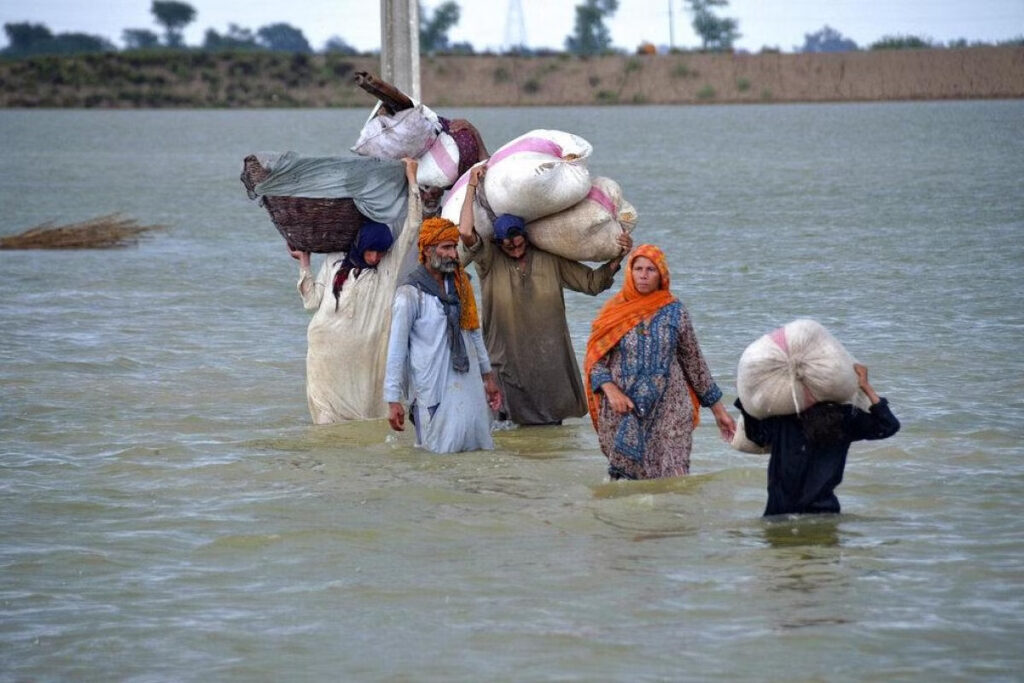Last year, Pakistan faced a catastrophic event as monsoon rains triggered unprecedented flooding throughout the country. This natural disaster destroyed countless lives and caused billions of dollars in damage. The scale of the devastation led many to describe it as a “monster monsoon,” leaving Pakistan pleading for help and highlighting the urgent need for action against man-made climate change.

Struggling to Survive: Life in the Aftermath of the Floods
In Dadu, one of the hardest-hit areas, stagnant water still covered the land, and those who remained were struggling to survive. The lack of assistance left many questioning the help they had received so far, especially concerning the health of their children. The local public hospital, months after the floods, continued to receive a constant influx of patients, including children born to flood victims.
Famine and Malnutrition: The Lingering Effects of the Floods
The floods wreaked havoc on Pakistan’s agricultural land, destroying over 4 million acres and leaving many without food. As a result, cases of malnutrition soared, particularly in the poorest regions of the country. Doctors witnessed an unprecedented spike in malnutrition cases, prompting the creation of dedicated wards to address the issue. The impact on the economy was significant, with the wheat and cotton crops severely damaged.
Multi-Front Challenges: Pakistan’s Troubled State
Pakistan faced numerous challenges simultaneously, exacerbating the effects of the floods. Prior to the subsiding of the rain, the country witnessed the ousting of Prime Minister Imran Khan, triggering mass protests. Islamic extremists also resurfaced, carrying out deadly terrorist attacks in various cities. These social and political upheavals, combined with an already weak economy, further crippled the nation.
Economic Crisis: Inflation, Poverty, and Dependence
The floods pushed an additional 20 million people below the poverty line, and inflation reached a 50-year high in Karachi, Pakistan’s financial capital. The devastation of the agricultural sector, which supports the livelihoods of 60-65% of the population, further worsened the economic situation. Pakistan’s dependence on foreign exchange to sustain its economy made it vulnerable to collapse without financial assistance from international organizations like the IMF.
The Need for Assistance: Insufficient Support and Recovery Challenges
Despite the scale of the disaster, Pakistan received only half of the required financial aid from other countries. Many flood victims reported a lack of help from their own government, with the recovery efforts largely dependent on assistance from UN agencies. The slow realization of pledged funds added to the frustration and desperation of those affected.
Climate Change, Future Threats, and the Quest for Resilience
Pakistan’s climate minister emphasized the need for developed nations to provide support, considering Pakistan’s low greenhouse gas emissions contribution. While the international community’s financial assistance helps address immediate needs, it falls short of future-proofing the country against recurring disasters. Future flooding and climate-related challenges remain a looming threat for Pakistan, necessitating long-term solutions and indigenous approaches to building resilience.
Despite the challenges, Pakistanis like Setia Chandio remain hopeful for a better future for their children. While the road to recovery is long and arduous, the resilience and determination of the people of Pakistan shine through. With collective efforts and effective measures, there is a possibility to mitigate the impact of future disasters and ensure a safer and more prosperous Pakistan for generations to come.
